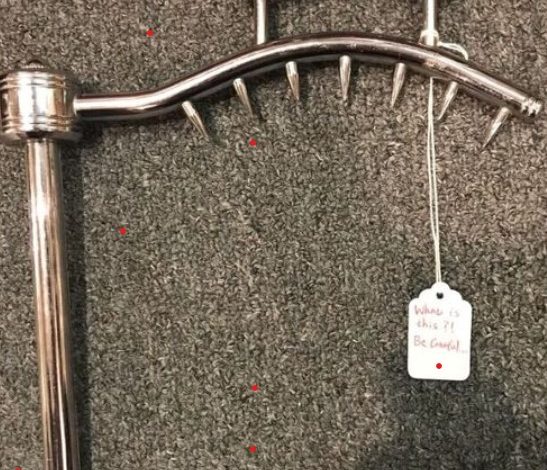Metal spiked thing at collectible store in MD. Indeed they didn’t know what it was

ADVERTISEMENT
Metal spiked thing at collectible store in MD. Indeed they didn’t know what it was
Lurching upon an unidentified protest in an collectible store is associated to finding a covered up treasure, starting interest and a detective-like journey to reveal its roots and purpose.
Such was the encounter at an collectible store in Maryland, where a unconventional metal spiked thing caught the consideration of customers and staff alike. Embellished with a tag that candidly conceded, “What is this!?”, this puzzling thing got to be the subject of theory and intrigue.
It wasn’t until the control of collective information, eminently from a web community on Reddit, came into play that the thing was at long last distinguished as a broil or ham holder, expecting to mount to a cutting board, which was, tragically, missing.
ADVERTISEMENT
At to begin with look, without the setting of its going with cutting board, the work of this metal spiked contraption was not quickly self-evident. Its plan, including sharp metal spikes orchestrated in a way that proposed they were implied to hold something in put, was both interesting and baffling.
The nonattendance of the cutting board, a vital component for its utilize, advance covered its reason in riddle, clearing out indeed the collectible store’s staff at a loss.
The revelation travel from an baffling metal question to a kitchen utensil with a particular work highlights the captivating world of culinary collectibles and the advancement of kitchen contraptions over time.
Broil or ham holders, such as the one found, were designed for common sense and ease within the kitchen, particularly in times when expansive cuts of meat were a centerpiece of eating and excitement. These holders, by safely securing the meat to a cutting board, encouraged the carving prepare, permitting for more exact and rich serving at the table.
The plan of the cook holder, with spikes to grasp the meat immovably, reflects a period when kitchen devices were created not fair for usefulness but with a thought for solidness and efficiency.
ADVERTISEMENT
The lost cutting board, likely made of wood, would have completed this kitchen outfit, giving a steady base for the holder and securing the table or countertop from scratches or harm amid the carving process.
This item’s journey from lack of definition to recognizable proof outlines the noteworthy part of online communities in fathoming riddles of the past. Stages like Reddit bring together people with assorted skill and interface, making a collective insights able of piecing together the perplexes cleared out behind by history.
In this case, the communal information made a difference not as it were in recognizing the question but moreover in increasing in value the resourcefulness of past eras in making apparatuses that made ordinary assignments more manageable.
Additionally, the story of the cook or ham holder may be a to the allure of collectible shopping, where each thing incorporates a story holding up to be uncovered. It reminds us of the significance of protecting and understanding the artifacts of lifestyle , as they offer experiences into the social and social hones of the past.
CA_NEWLINE_CA For devotees of culinary history, such things are a window into the advancement of cooking and eating traditions, reflecting changes in innovation, taste, and lifestyle over time.
ADVERTISEMENT
In conclusion, the metal spiked thing, initially met with confusion and curiosity at a Maryland antique store, reveals the rich tapestry of culinary history and the evolution of kitchen tools.
Its identification as a roast or ham holder, designed to mount to a cutting board, underscores the value of community knowledge in unraveling historical mysteries. This discovery not only enriches our understanding of past culinary practices but also celebrates the joy of exploration and the continuous quest for knowledge about the objects that have served generations before us.




